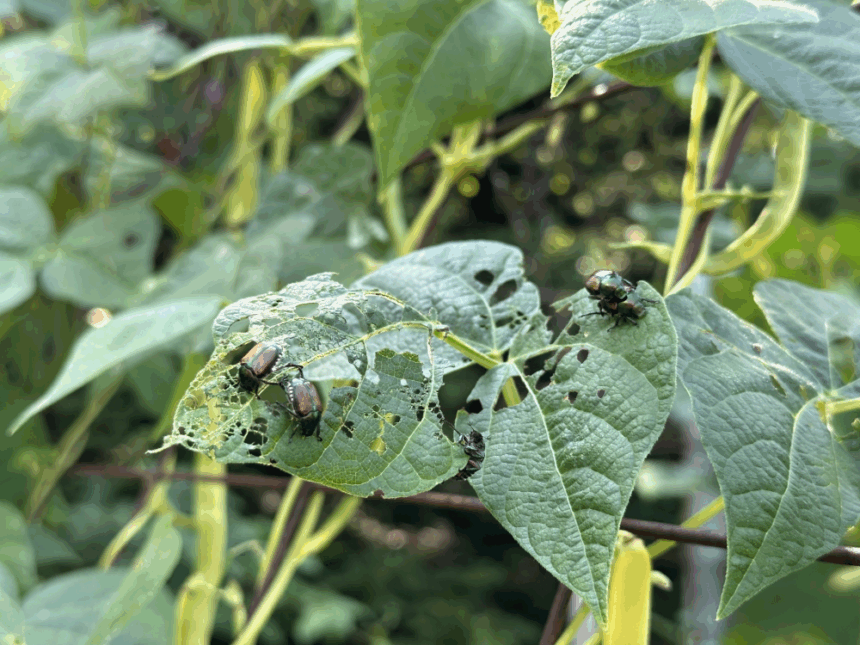With their metallic copper and green colouring, Japanese beetles are easy to identify. Handpick often to limit damage. Photo by Niki JabbourArticle contentSo far, it’s been a challenging season for my garden. Not only have I been battling a ravenous groundhog, but the slugs devour my beans and melons the moment they sprout.THIS CONTENT IS RESERVED FOR SUBSCRIBERS ONLY.Subscribe now to access this story and more:Unlimited access to the website and appExclusive access to premium content, newsletters and podcastsFull access to the e-Edition app, an electronic replica of the print edition that you can share, download and comment onEnjoy insights and behind-the-scenes analysis from our award-winning journalistsSupport local journalists and the next generation of journalistsSUBSCRIBE TO UNLOCK MORE ARTICLES.Subscribe or sign in to your account to continue your reading experience.Unlimited access to the website and appExclusive access to premium content, newsletters and podcastsFull access to the e-Edition app, an electronic replica of the print edition that you can share, download and comment onEnjoy insights and behind-the-scenes analysis from our award-winning journalistsSupport local journalists and the next generation of journalistsRegister to unlock more articles.Create an account or sign in to continue your reading experience.Access additional stories every monthShare your thoughts and join the conversation in our commenting communityGet email updates from your favourite authorsSign In or Create an AccountorArticle contentThat said, we’re currently enjoying a glut of cucumbers, peas and new potatoes and it won’t be long before the first tomatoes are ready to pick. It’s all about balance.Article contentArticle contentOf course, not all insects are pests. It’s estimated that around 95 per cent of the ones you spot in the garden are either beneficial or neutral, in that they don’t do any damage. I’ve been seeing lots of helpful insects, such as ladybugs, lacewings and hoverflies, which prey on pests like aphids. To entice these garden good guys, plant a wide variety of flowers and herbs in your garden, such as sweet alyssum, cosmos, dill, yarrow, and calendula.Article contentArticle contentBelow, you’ll find tips on how to tackle four common summer pests that can quickly decimate garden plants.Article contentSlugsArticle contentThese land-based mollusks are voracious in their appetite, happily damaging leaves, newly sprouted seedlings and flowers. The first clue that you’re dealing with slugs is a trail of slime. To be sure, head out to the garden early in the morning or in the evening to have a peek. They prefer cool, damp conditions and hide during the heat of the day. Look closely, as newly hatched slugs are tiny, while the adults can be an inch or two long.Article contentMy strategy is to hand-pick any slugs I find and pair this with a layer of diatomaceous earth sprinkled on the soil around my plants. This discourages slugs as they don’t like to cross the fine powder. Reapply after a rain or watering. You can also apply an organic slug bait around plants.Article contentArticle content Slugs are a common garden pest that quickly devastates young vegetable and flower seedlings. Handpick or use diatomaceous early to reduce their populations. Photo by Niki JabbourArticle contentStriped cucumber beetlesArticle contentArticle contentThis widespread pest attacks all members of the cucumber family, including cucumbers, squash, gourds and melons. They leave ragged holes in the foliage and also eat the flowers. That’s bad enough, but cucumber beetles also transmit bacterial wilt, which quickly kills the plants.Article contentThe small, slender beetles are yellow with black stripes, and they can be reduced by hand picking. I find it helpful to dip a wooden dowel, plastic spoon, or other narrow object in petroleum jelly and use that to ‘collect’ the beetles from the plants. Your best bet, however, is to use insect netting or row covers over plants, setting them in place just after planting. Remove once the flowers open to allow for pollination.Article content Cucumber beetles nibble leaves and flowers, but they also transmit bacterial wilt which quickly wipes out a healthy plant. Photo by Niki JabbourArticle contentJapanese beetlesArticle contentFor the past few years, Japanese beetles have been the major summer pest in most Nova Scotian gardens. These one-centimetre-long, copper and green beetles are easy to identify and are found on over 300 species of shrubs, perennials, annuals and vegetables. They feed on the leaf tissue between the veins, resulting in skeletonized foliage.
Niki Jabbour: Bugs, grubs and summer slugs and what to do about them











